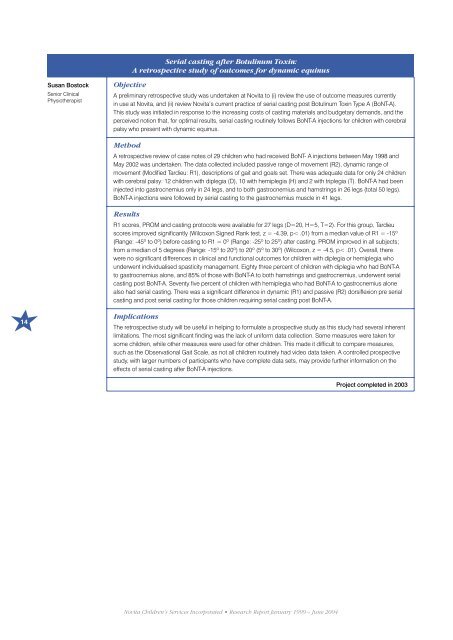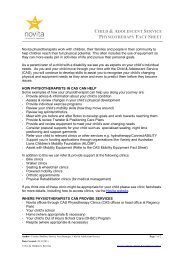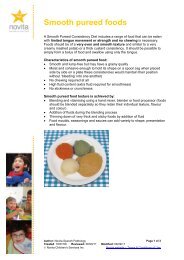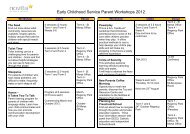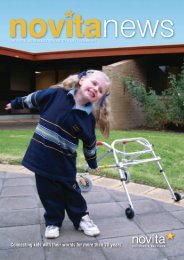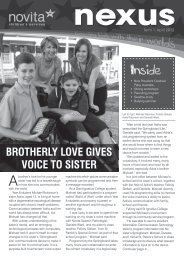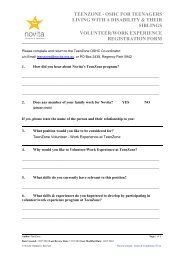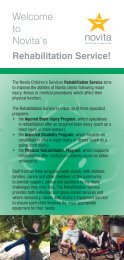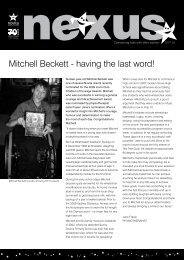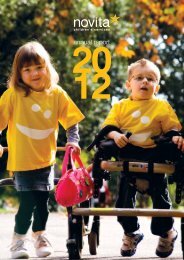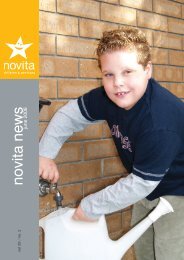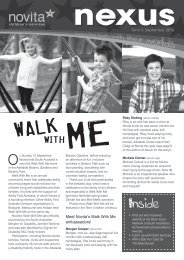Novita Research Report January 1999 - Novita Children's Services
Novita Research Report January 1999 - Novita Children's Services
Novita Research Report January 1999 - Novita Children's Services
You also want an ePaper? Increase the reach of your titles
YUMPU automatically turns print PDFs into web optimized ePapers that Google loves.
Serial casting after Botulinum Toxin:<br />
A retrospective study of outcomes for dynamic equinus<br />
Susan Bostock<br />
Senior Clinical<br />
Physiotherapist<br />
Objective<br />
A preliminary retrospective study was undertaken at <strong>Novita</strong> to (i) review the use of outcome measures currently<br />
in use at <strong>Novita</strong>, and (ii) review <strong>Novita</strong>’s current practice of serial casting post Botulinum Toxin Type A (BoNT-A).<br />
This study was initiated in response to the increasing costs of casting materials and budgetary demands, and the<br />
perceived notion that, for optimal results, serial casting routinely follows BoNT-A injections for children with cerebral<br />
palsy who present with dynamic equinus.<br />
Method<br />
A retrospective review of case notes of 29 children who had received BoNT- A injections between May 1998 and<br />
May 2002 was undertaken. The data collected included passive range of movement (R2), dynamic range of<br />
movement (Modified Tardieu: R1), descriptions of gait and goals set. There was adequate data for only 24 children<br />
with cerebral palsy: 12 children with diplegia (D), 10 with hemiplegia (H) and 2 with triplegia (T). BoNT-A had been<br />
injected into gastrocnemius only in 24 legs, and to both gastrocnemius and hamstrings in 26 legs (total 50 legs).<br />
BoNT-A injections were followed by serial casting to the gastrocnemius muscle in 41 legs.<br />
Results<br />
R1 scores, PROM and casting protocols were available for 27 legs (D=20, H=5, T=2). For this group, Tardieu<br />
scores improved significantly (Wilcoxon Signed Rank test, z = -4.39, p< .01) from a median value of R1 = -15º<br />
(Range: -45º to 0º) before casting to R1 = 0º (Range: -25º to 25º) after casting. PROM improved in all subjects;<br />
from a median of 5 degrees (Range: -15º to 20º) to 20º (5º to 30º) (Wilcoxon, z = -4.5, p< .01). Overall, there<br />
were no significant differences in clinical and functional outcomes for children with diplegia or hemiplegia who<br />
underwent individualised spasticity management. Eighty three percent of children with diplegia who had BoNT-A<br />
to gastrocnemius alone, and 85% of those with BoNT-A to both hamstrings and gastrocnemius, underwent serial<br />
casting post BoNT-A. Seventy five percent of children with hemiplegia who had BoNT-A to gastrocnemius alone<br />
also had serial casting. There was a significant difference in dynamic (R1) and passive (R2) dorsiflexion pre serial<br />
casting and post serial casting for those children requiring serial casting post BoNT-A.<br />
14<br />
Implications<br />
The retrospective study will be useful in helping to formulate a prospective study as this study had several inherent<br />
limitations. The most significant finding was the lack of uniform data collection. Some measures were taken for<br />
some children, while other measures were used for other children. This made it difficult to compare measures,<br />
such as the Observational Gait Scale, as not all children routinely had video data taken. A controlled prospective<br />
study, with larger numbers of participants who have complete data sets, may provide further information on the<br />
effects of serial casting after BoNT-A injections.<br />
Project completed in 2003<br />
<strong>Novita</strong> Children’s <strong>Services</strong> Incorporated • <strong>Research</strong> <strong>Report</strong> <strong>January</strong> <strong>1999</strong> – June 2004


